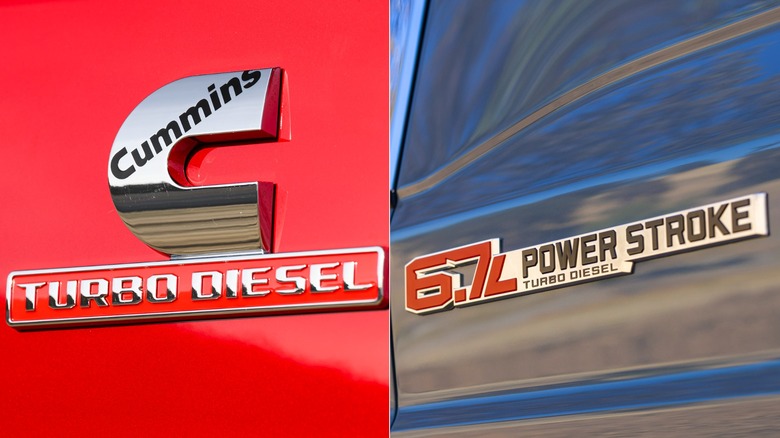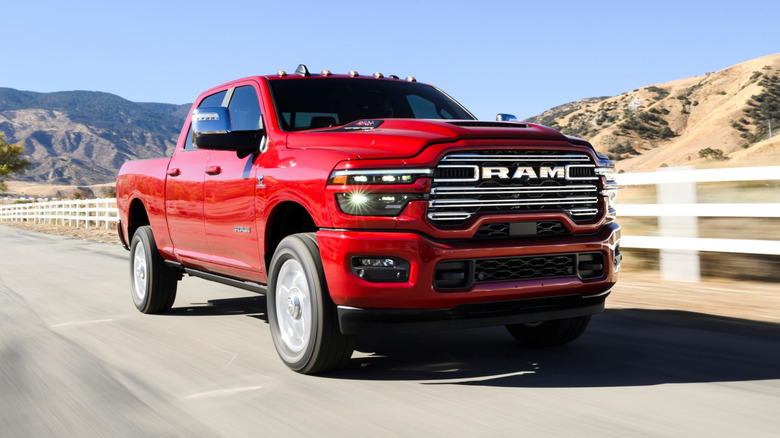6.7 Cummins Vs 6.7 Powerstroke: How The Two Diesel Engines Compare
If you've been considering a Ram or Ford heavy-duty truck for your next purchase, you might be wondering about how the 6.7 Cummins and Ford 6.7 Powerstroke compare, and understandably so. These two are among the most popular diesel engine options in the U.S., as they offer very high power output and a shared desire to deliver low-end grunt and excellent fuel economy. Both engines have also been around long enough to establish themselves as some of the most reliable diesel engines ever built. The 6.7 Cummins arrived first, having debuted in 2007 as a replacement for the 5.9-liter 24 Valve Cummins ISB engine, whereas the 6.7 Powerstroke first made its way into Ford's heavy-duty trucks in 2011 as a successor to the 6.4-liter Powerstroke diesel engine.
Beyond their launch dates, the oil-burners are also different in their configurations. While the 6.7 Cummins turbodiesel is an inline six-cylinder engine, Ford's 6.7 Powerstroke is a V8. And, despite both engines having the same 6.7 liters of displacement on paper, the Cummins powerplant has a larger bore of 4.21 inches against 3.9 inches and a longer 4.88-inch stroke as opposed to 4.25 inches for the Ford Powerstroke engine. But that's not at all surprising when you consider that the Powerstroke has two more cylinders. Here's a further look at how the 6.7 Cummins stacks up to the Ford 6.7 Powerstroke mill.
6.7-liter Cummins Turbo Diesel
Cummins' current 6.7-liter turbodiesel engine is the culmination of years of partnership and continual development, which includes the use of turbocharging and a high-pressure common rail direct injection system to enable the engine to produce lots of power and torque. Upon launching as the roaring heart of Dodge Ram's heavy-duty trucks, the 6.7 powerplant initially generated 350 horsepower and 610 lb-ft of torque in models equipped with the standard six-speed manual transmission, while those with the available six-speed automatic made 40 extra pounds of torque. Fast-forward to 2025 and those numbers are now up to 430 horsepower and 1,075 lb-ft by just 1,800 rpm.
Impressively, Cummins took measures to ensure all that power is delivered to the ground with as minimal impact as possible to climate and health. This was achieved through emissions-reducing technologies like exhaust gas recirculation (EGR), diesel particulate filter (DPF), selective catalytic reduction (SCR), and diesel oxidation catalyst (DOC). But like any modern diesel engine, these systems have had effects on the Cummins 6.7 engine reliability, with some drivers experiencing issues with clogged DPFs and cracked EGR coolers. Fortunately, some of these problems mostly occur on pre-2013 6.7s and can't seem to dampen the engine's appeal, especially in light of its incredible capability so far. When appropriately equipped, a 6.7 Cummins-engined heavy-duty pickup truck can tow up to 36,610 pounds and carry a max payload of 6,050 pounds.
Ford 6.7 Powerstroke V8
Like the Cummins 6.7, the Powerstroke 6.7 diesel engine is packed with emissions and performance-related tech. These include exhaust gas recirculation, diesel particulate filter, selective catalytic reduction, turbocharging, and high-pressure common-rail fuel injection system. However, the V8 has a lot more power than the Cummins inline-six engine, with its high-output variant able to produce 500 horsepower and 1,200 lb-ft of torque (at a lower 1,600 rpm). In standard guise, the Ford engine still has an impressive 475 horsepower and 1050 lb-ft, which is about 45 more hp but 25 less torque than the Cummins engine.
Unsurprisingly, the Powerstroke's muscle gives it a lot more towing performance, as when appropriately equipped, the high-output engine can tow up to 40,000 pounds and carry a payload of 6,935 pounds. The standard-output engine, for its own part, is rated to tow a maximum of 38,600 pounds and carry a 6,952-pound payload. It's a highly capable powerplant, but, as with the Cummins diesel engine, there are concerns over the 6.7 Powerstroke. Early examples of the engine can suffer from turbo failure due to weak ceramic ball bearings in the dual-boost turbocharger, and, issues like injection-pump failure, broken glow plugs, and EGR cooler problems are also common.


